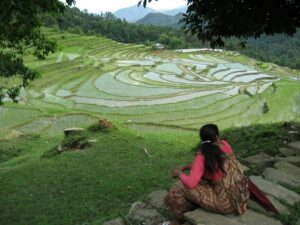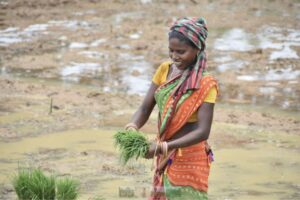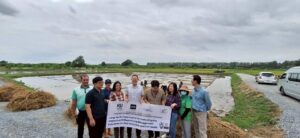
In 2008, the Saudi Binladin Group began negotiations with the Indonesian government to invest US$4.3 billion in 1.6 million hectares in Papua Province, primarily to grow basmati rice for export back to Saudi Arabia. In the same year, China negotiated to lease more than 1 million hectares of rice land in the Philippines. These were two of the largest of a host of similar plans put forward by interests from economically powerful nations that faced serious agricultural challenges in their respective countries and, in the wake of the 2007-08 food crisis, had lost faith in international food markets. And, the deals haven’t been restricted to rice. Also in 2008, Korea’s Daewoo Logistics Corporation brokered a deal for a 99-year lease on 1.3 million hectares in Madagascar (around half the country’s arable land) to grow maize and oil palm.
It sounds like good business and potentially win-win. Wealthy governments or companies buy land and set up large-scale agricultural operations in poorer countries, which have land and water but not the resources, infrastructure, or technologies to do it themselves. With improved tools, the local farmers increase their productivity and get paid (relatively) well for their efforts. The foreign entities take the profits and food back home. The modern technologies and expertise remain in the host country, eventually trickling down to other farmers across the land, resulting in better production and increased wealth.
But not so fast.
To start with, you need to look at the reason behind these deals. In the case of rice, there’s simply not enough on the planet. According to the International Rice Research Institute (IRRI), the supply-and-demand equation needs to be such that rice export prices stay around US$300 a ton in the long term (Fig. 1). At that level, poor farmers are able to make a profit but rice remains affordable for poor consumers. To achieve this, “Each year we need to produce an additional 8–10 million tons of rice more than in the previous year for the next 20 years,” says IRRI Director General Robert Zeigler. Many rice-dependent countries need to supplement their own production to varying degrees by importing rice. In the 20–30 years up to 2008, thanks to a relatively reliable international market, importing was a safe policy. All that changed, however, during the food crisis of 2007-08, which saw rice export prices more than triple in barely a few months. Suddenly, rice imports became prohibitively expensive. Although things have settled over the past 2 years,prices remain substantially higher than they were before the crisis and many importing countries have had their faith in the market well and truly eroded.

Support for agriculture
The silver lining in the food-crisis cloud has been a long-awaited reinvigoration of support for agricultural research and development. This is helping some importers increase their rice production domestically in several ways, including improved technologies to increase yields on existing rice land, irrigation schemes that allow two or even three crops to be grown per year instead of just one, and additional farming land that was previously unsuitable for rice production (e.g., through the use of salt-tolerant rice varieties). Other strategies—with more potential downsides—include converting to rice production natural ecosystems or land used for other agricultural activities.
Nevertheless, the level of support for public agricultural research remains well below that required to make a real and lasting difference. The Food and Agriculture Organization (FAO) of the United Nations has calculated that, to achieve the Millennium Development Goal of halving the world’s hungry by 2015, funding of at least $30 billion is needed every year above the current levels of support for the agricultural sector in developing countries. With the share of international aid directed to agriculture trending downward in recent years (now below 5%; see Fig. 2), official development assistance offers a supplement at best.1 On the other hand, some economically better-off countries are physically unable to sufficiently increase their domestic production. Countries such as China and several of the Gulf States—burdened variously by large populations, rapidly growing industrial and domestic sectors that put pressure on natural resources, or lack of water (along with a lack of confidence in international markets)—have both the need and the money to invest in rice production beyond their own borders.

Grab for lands
The idea of one country growing food in another in order to export it back home is nothing new. But, according to the International Food Policy Research Institute (IFPRI),2 it’s a phenomenon that has accelerated amid the aftershocks of the 2007-08 food crisis. The FAO estimates that foreign interests acquired up to 20 million hectares in Africa alone in 2007-09.3 The Gulf States—which already import more than half their food and whose populations are projected to increase by 50% in the next 20 years—are the major investors at this stage, with China and South Korea also involved in significant deals.
Africa remains the major target for land acquisitions but Southeast Asia and South America have also seen investor interest (Fig. 3). Recent investments have involved government-to-government, private sector-to-government, and private sector-to-private sector deals, along with agricultural investment funds that offer finance to private investors. Ironically, the desire to ensure food security and stable domestic prices was in itself a major reason behind the price rises, as major exporters restricted or banned exports and major importers scrambled to secure rice at almost any cost. The resulting problems—rising domestic prices (despite, or possibly because of, the attempts to avoid this) and civil unrest in several countries—reinforced in the minds of politicians the importance of ensuring adequate domestic supplies.
The potential for such projects to bring agricultural investment to countries that sorely need to increase their own production is undeniable. But, if things are done poorly, poor farmers in target countries can lose control over and even access to the land on which they depend for their livelihood. Further, it doesn’t take too much to imagine a situation in which local communities dependent on rainfed agriculture struggle to produce sufficient food, while foreign interests export food grown on well-resourced, irrigated farm compounds. It’s not a scenario likely to be accepted gracefully by the hungry. Sure enough, the three land deals mentioned earlier—in Indonesia, the Philippines, and Madagascar—were all scrapped or postponed after public outrage and resistance from local communities. The Madagascar deal reportedly influenced the political unrest that engulfed the country and led to a change of government in 2009.
Code of Conduct
To reap the potential benefits of international land acquisition and avoid win-lose results, there is general agreement that appropriate policies and enforceable regulations must be drawn up and followed strictly. As a starting point, IFPRI has suggested a code of conduct (see A code of conduct for international land acquisition). It is crucial that any such code rise above mere well-meaning statements that are largely ignored by the more powerful of the actors in any land deals. Existing legal frameworks—such as business laws adopted to prevent corruption in foreign direct investment—could serve as models for agricultural land acquisitions.
The FAO concurs,3 pointing out that, in many of the recent major land deals, negotiations have been predominantly between the investor and the host-country government, with minimal consultation with local populations. Although the rights of small-scale landowners remain poorly documented (if at all), it is next to impossible for local communities to make claims on a legal basis. This situation is compounded by the fact that much land that may be considered “surplus” is not necessarily unused or unoccupied. Thus, there is an urgent need for better systems and processes to deal with land rights. For investors, adhering to fair regulations, which, in addition to land rights, would also consider labor and environmental standards, would not necessarily be an altruistic act. Deals brokered fairly would be more likely to avoid the public dissent seen recently and thus stand a better chance of succeeding.
A 2009 study,4 commissioned by FAO and the International Fund for Agricultural Development and conducted by the International Institute for Environment and Development, reinforces the need for free, prior, and informed consent of local communities as a prerequisite for any land acquisition to proceed.
“In many countries, provisions for including local people in decision making are usually absent or poorly implemented and this increases the risk of them losing access to land and other resources,” says Sonja Vermeulen, one of the report’s co-authors.
One suggestion is the development of a land-acquisition framework based on the Extractive Industries Transparency Initiative (EITI), which aims to strengthen governance and improve transparency and accountability in the oil, gas, and minerals sector of resource rich, low-income countries. The EITI helps to reduce corruption through the verification and full publication of company payments and government revenues from oil, gas, and mining.
Given that international land acquisitions are unlikely to disappear, it is crucial that affected communities in target countries benefit from the deals.The potential for benefits is undeniable—if the deals are done well, the inflow of money and other resources along with new technologies and knowledge can result in improvement and increases in productivity and job creation, and even bring associated multiplier effects throughout both the agricultural sector
and the communities at large. With the right processes in place, more food can be produced for domestic consumption, as well as for export (see From roses to rice).
The FAO,3 however, warns that such benefits will fail to materialize if investment creates a closed system of advanced agriculture that local smallholders are unable to access or reproduce themselves. For example, highly mechanized production and the use of imported inputs may negate job creation and ongoing local investment, and unsustainable environmental practices, poorly monitored and policed, can cause land degradation and depletion of water resources. Nevertheless, there are also historical examples of long term benefits, including improved technologies, marketing systems, and product quality.
IRRI, which is not involved in any projects on land acquisition for rice production, maintains that the long-term solution lies in countries increasing their own rice production, particularly on existing agricultural land (clearing uncultivated land is considered a last option).
Dr. Zeigler says that a range of strategies an achieve this in an environmentally benign way: “These include many technological innovations. However, more importantly, governments must negotiate terms that assure participation of the rural sector in any land development schemes. Likewise, there must be clear policies that provide for channeling some of the surplus production from development schemes to markets in the host country. That way, host countries can replace their own costly imports while the investor country assures its own supplies. We have been complaining for decades now that there has been insufficient investment in rural infrastructure in many developing countries. It will be a pity if we know such investments are forthcoming, yet we simply wring our hands in fear and fail to seize a real opportunity.”










